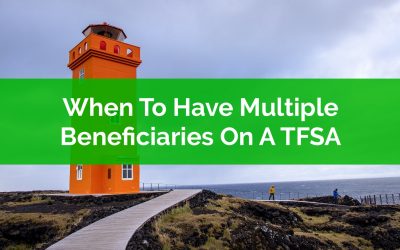Thank you for joining the waitlist!
You’re on the list for early access!
We will contact you via email when we’re ready for you to start your self-directed financial plan. In the mean time here is a quick preview…
Check out our latest blog posts…
When To Have Multiple Beneficiaries On A TFSA
A TFSA is often the last account that we want to draw on in retirement. There are some great tax advantages to the TFSA because it allows contributions to keep growing tax free even in late retirement. New contribution room is accumulated each year and the account also regains the contribution room the following year after withdrawals have been made.
Because the TFSA is often the last to get drawn down in retirement this means that the TFSA will most likely make up a large portion of any future estate.
How large can a TFSA get? It’s reasonable to expect that with new contributions and investment growth we’ll see many TFSAs in the $1M to $2M range in the future!
The potential size of TFSAs in the future makes it important to understand how TFSAs can be passed on after death. There are a few options to consider and one option is to have multiple beneficiaries on a TFSA.
But is having multiple beneficiaries on a TFSA the right option for your estate plan? In this post we’ll look at why you may want to name multiple beneficiaries on your TFSA and some of the other options you may want to consider.
Four Easy Ways To Save Money Each Month
There are lots of easy ways to save money each month but these four are probably the easiest.
Saving and investing on a regular basis is a key way to achieve financial goals. Creating a strong habit is important to accumulating a significant amount of wealth. Without a regular habit of saving and investing it can be quite difficult to make significant progress.
Even a small change can have a significant impact if it’s done consistently over a long period of time. There isn’t a big difference between financial success and financial stress. Even as little as $10/day can have an enormous impact over the course of a few years. Extrapolated over decades the difference is staggering.
Thankfully with technology this can be made quite easy. There are a few simple ways to save money each month. And accounts like the TFSA and RRSP make that even easier. They allow contributions to compound tax free, providing a significant boost to savings and investments.
There are a few easy ways to save money each month. The four ways we’ll focus on in this post all use automation. They take advantage of programs or systems that already exist. This helps make it easier to setup and maintain a healthy savings habit.
Automation is great, it helps maintain a good habit, and it makes it easy to “set it and forget it”. Best of all, automation means that we typically don’t even see this happening each month. By automating contributions to savings and investments we hardly miss the money being funneled away for future goals.
What Is The Cost Of Mortgage Deferral?
Having the option to defer mortgage payments has been a great source of relief for many Canadians. The large banks introduced options to defer up to 6-months of mortgage payments. But what is the cost of mortgage deferral and how does your mortgage change in the future?
The option to defer mortgage payments has been incredibly helpful for those with reduced income or cash flow. It’s provided an enormous amount of relief. It’s even allowed some people to build up a small amount of emergency savings (a personal finance best practice).
But what is the cost of these reduced payments? How will interest be accrued? What options do you have to reduce this accrued interest in the future?
In this post we’re going to use our free debt calculator to estimate the cost of mortgage deferral. We’re going to explore how the deferral impacts both short-term and long-term finances. Plus we’ll look at how different repayment options may impact the total amount of interest paid and the length of time to mortgage freedom.



